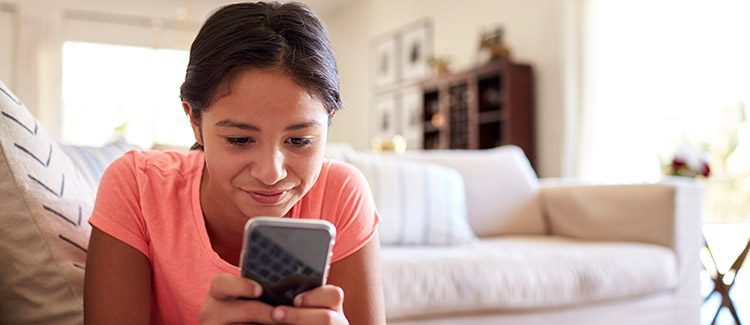Remember when you worried that being connected to social media 24/7 was distracting your kid from their homework? That communicating solely in emojis and acronyms during their formative years would stunt your child’s ability to form deep and meaningful relationships? As schools around the country scramble to support at-home learning and families struggle with caring for school-age kids at home for who knows how long, worries about our kids being too connected already seem like a quaint relic of that long-ago time Before Coronavirus.
“Ironically, the same technologies we often blame for tearing apart our social fabric might be our best chance, now, of keeping it together,” says Stanford psychologist Jamil Zaki. While staying apart to halt the spread of COVID-19 is necessary, the term ‘social distancing’ sends the wrong message, Zaki says. “We should think of this time as ‘physical distancing,’ to emphasize that we can remain socially connected even while being apart.” That’s important for kids because when school is closed and kids are cut off from daily interactions with their peers, academic ground isn’t the only thing they stand to lose.
“They’re missing the space to co-create, to learn from each other, to try things out,” says Marín Trujillo, community engagement coordinator for West Contra Costa Unified School District in Richmond, CA.
Trujillo says there’s been a real demand in his district, particularly among middle school and high school students, for digital spaces where kids can just hang out together. It may come across as boredom or loneliness he says, but kids are missing out on an important aspect of their development — the chance to understand themselves in relation to others and to try out new things. “We see this with teenagers, who are developing their personalities — Am I this? Am I that? Can I be two things at once? — all of these things develop through social engagement in unsupervised space.”
While older kids likely won’t need your encouragement to stay in touch with their friends, here are a few ideas for keeping kids of all ages socially connected as long as in-person interactions are off-limits.
It’s the little pings that count
For younger kids who aren’t yet glued to a device of their own, small points of contact, such as a FaceTime call or Google Hangout with a classmate while doing independent work or an art playdate, can help keep them from feeling isolated. If you’re feeling it yourself, consider organizing a group session with a few other parents and kids where the adults take turns reading to the group.
“We got nine families on a single conference call where each kid shared something for show and tell, the meals they’ve been eating, ways to pass the time, and at the end each mom read a book of their child’s choosing. It was so nice watching the kids connect and I realized it wasn’t just for them, it was for us, too,” Los Angeles preschool mom Emily Schuman posted on Instagram.
Make something out of nothing
To mimic what kids get from real-life group interactions, I like kid-led sessions where there’s an activity to accomplish or a problem to be solved. My teenager got 6 friends together in a Zoom meeting to record an audio book. They could all see each other as they worked out how to divvy up roles and laugh about flubbed lines. Zoom is used by many schools and universities for meetings and classes. It’s also good for hanging out with a friend while doing an independent activity (baking cookies, cleaning their room, eating lunch) or doing nothing at all. Parents should be aware that the recent popularity of the platform has led to widespread abuse; make sure your child knows never to share a meeting link on social media, and not to join a group meeting unless it’s made up only of people they know and trust.
Good in groups
If your child is in middle school or older, it’s a pretty safe bet they know more than we do about staying virtually connected. But being physically estranged may make them shyer than usual. If it seems like they could use a little nudge, you could always suggest a group FaceTime. (If you need a tutorial on how to group-FaceTime, there’s one here.)
You can do your part by looking more benignly than usual on group chats while class is in session or while homework is being done, because those interactions are more important than ever right now. “On Instagram, my hive has a big group chat where we talk about our assignments and how bored we are,” one high school student told me. Being more relaxed about the amount of time your tween or teen spends chatting, of course, does not mean relaxing your family’s rules for safe and responsible digital interactions.
Do something remotely enriching
Be on the lookout for notice from coaches, choir directors, or band teachers that practices or rehearsals have moved to Facebook Live or Zoom. While these adult-facilitated sessions might not include much kid-to-kid interaction, they’re a shared experience your child can roll their eyes about in a group chat later.
Play well with others
Anecdotal reports from a small sample of middle schoolers suggests that playing video games on a shared server is still one of the most popular ways for kids to hang out together. You know, just like before the lockdown. If your kid isn’t into video games, or if you’re looking for a multigenerational family activity, you could make a puzzle with your own photo at I’m a puzzle and then share the link on the platform of your choice so the group can assemble it together. Or play charades or pictionary using a random word generator. And while sleepovers are verboten, kids can simulate one by using Netflix Party, an extension for the Chrome browser that lets friends in different locations watch Netflix together.
You may need to experiment with a few experiences to get your children to adapt to the idea of distant socializing while school is closed. Ask your children what they miss and what ideas they have for replacing those interactions. Please share your (and your kids’) ideas in the comments below! We’ll all likely come out of this strange time with lots of new ways to engage with friends far and near.






